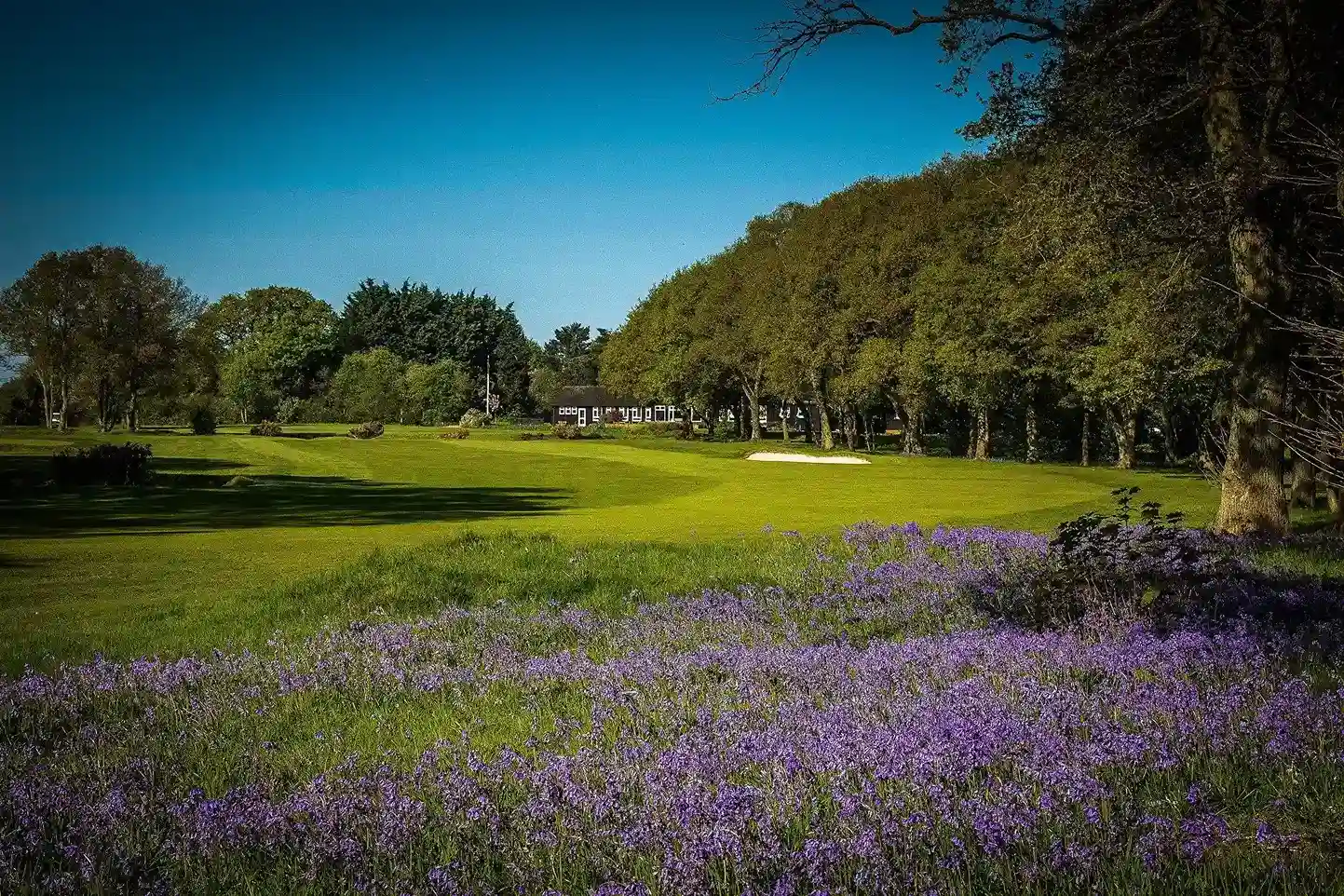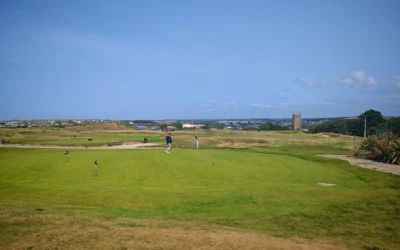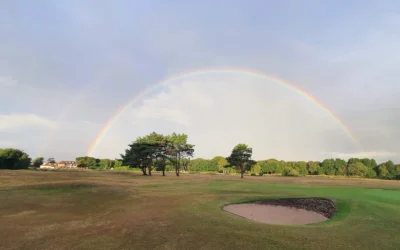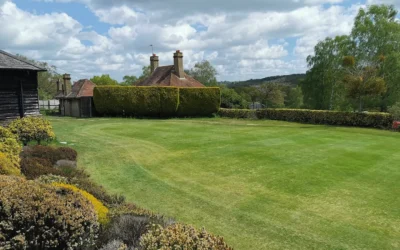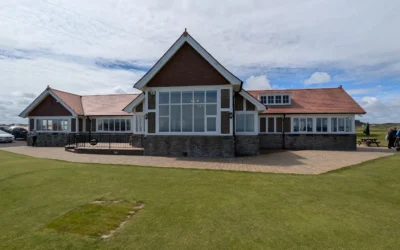Huntercombe Golf Club
Huntercombe Golf Club (Nuffield, Oxfordshire, England)
Nestled in the heart of the Chiltern Hills, an Area of Outstanding Natural Beauty, Huntercombe Golf Club stands as a timeless monument to the golden age of golf course design. Established in 1901 by Willie Park Jr., a two-time Open Champion, this heathland masterpiece captivates with its strategic brilliance and serene landscapes. From the elevated tee of the first hole, golfers are greeted with sweeping views across the Thames floodplain, setting the stage for a round that blends challenge with charm. The course’s signature grass “pots”—over 100 natural hollows—replace traditional bunkers, demanding precision and creativity.
Largely unchanged for over a century, Huntercombe offers a rare opportunity to walk in the footsteps of golfing legends and cultural icons like Ian Fleming, who immortalized the course in Goldfinger. Ranked 57th in England by Golf World (2024), Huntercombe promises an unforgettable experience steeped in history and natural splendor.
Key Details
- Location: Nuffield, Henley-on-Thames, Oxfordshire RG9 5SL, United Kingdom
- Length: 6,319 yards
- Par: 70
- Designers: Willie Park Jr. (1901), Hawtree Ltd
- Established: 1901
- Notable Events: Associated with figures like Ian Fleming and Henry Longhurst; ranked 57th in England by Golf World (2024)
History and Significance
In 1900, Willie Park Jr., a revered figure in golf with Open Championship victories in 1887 and 1889, acquired Huntercombe Manor and over 900 acres, plus 113 acres of common ground, to realize his vision of an ideal inland course. Opened in May 1901, Huntercombe was the only course Park owned, granting him unparalleled freedom to craft a layout that reflected his design philosophy, influenced by iconic links like North Berwick, Prestwick, and St.
Andrews. His innovative use of grass “pots”—over 100 natural hollows as hazards—set Huntercombe apart, earning acclaim from American golfer Walter Travis, who in 1901 declared it “easily the best laid out links I have played over anywhere”. This bold design, with minimal bunkers (fewer than 25 initially, now 13), marked the dawn of the Golden Age of golf architecture, predating Augusta National’s similar concepts by 31 years. Huntercombe’s layout has seen minimal alterations, preserving its historical integrity. Until 1963, the par-4 14th served as the first hole, with the original clubhouse—now luxury homes—located across the A4130.
Recent restoration by architect Tim Lobb has revived features like the “Park-like” pits on the 16th and cleared overgrown vegetation to restore vistas, enhancing the course’s original open character. Situated 700 feet above sea level, the course benefits from chalky sub-soil, ensuring excellent drainage and year-round playability, as touted in early advertisements describing it as “a perfect seaside course – inland” with “health-giving breezes”. The course’s cultural significance is profound.
Ian Fleming, creator of James Bond, was a member for 32 years until 1964, famously referencing Huntercombe in Goldfinger, where Bond claims a 9 handicap at the club. Golf commentator Henry Longhurst, a member from 1951, further embedded Huntercombe in golfing lore. Early members included architects C.K. Hutchison, J.F. Abercromby, Stuart Paton, and Charles Hugh Alison, underscoring its influence on course design. The club’s prestige extended to figures like Sir David Spedding, former MI6 head, and members of Parliament, reflecting its elite status.
Today, Huntercombe holds a ranking of 57th in England and 124th in Britain & Ireland by Golf World (2024, 2025), affirming its enduring appeal. Its secluded location, 45 miles northwest of London, has safeguarded its traditional ethos, making it a pilgrimage site for those seeking an authentic golfing experience rooted in history and innovation.
Course Features
Huntercombe is a heathland course that, while originally open, is now framed by mature oaks and carefully managed woodland, with vibrant bluebells in spring. Its largely flat terrain, except for the elevated 2nd and 3rd holes, ensures an easy walk, yet its strategic design challenges golfers of all abilities. The fairways, described as “immemorial turf,” are meticulously maintained, and the greens, with their bold contours and shelves, demand precision and creativity.
The course’s defining feature is its grass “pots,” over 100 hollows that serve as hazards in place of traditional sand bunkers, of which there are only 13. These pots, varying in depth and shape, are strategically placed on holes like the 3rd, 4th, 5th, 6th, 9th, 13th, 14th, 15th, 16th, and 17th, dictating play and rewarding thoughtful shot-making over power. At 6,319 yards (par 70), Huntercombe balances accessibility with challenge, with gorse and heather adding natural hazards.
The greens are among Britain’s most distinctive, with many featuring dramatic tiers and slopes. The 4th green, for instance, has a quadrant significantly lower than the rest, while the 15th’s sunken “basin green” tests depth perception. These surfaces run fast and true, requiring careful reading and adaptability. Park’s mastery of visible deception and blindness, evident on holes like the 1st, 4th, and 17th, adds intrigue, making each shot a puzzle.
Scenically, Huntercombe is breathtaking. The view from the 1st tee across the Thames floodplain to the Wittenham Clumps is iconic, while red kites—the club’s emblem—soar overhead, enhancing the natural ambiance. The Chiltern Hills setting ensures a serene escape, with sandy loam soil supporting year-round playability. The routing, particularly from the 8th to 13th holes, is genius, navigating an awkward triangular plot without monotony. The course’s swift pace, with rounds often under three hours, allows golfers to savor both the game and the setting.
Signature Holes
Huntercombe’s holes reflect Willie Park Jr.’s genius, blending strategy and beauty. Below are four standout holes:
1. Par-3 1st Hole (170 yards)
The opening par-3 sets the tone with an elevated tee offering panoramic views across the Thames floodplain to the Wittenham Clumps. The 170-yard shot demands precision to a two-tiered green, with the front lower than the back, guarded by grass pots and a bunker. This hole introduces Huntercombe’s strategic depth and scenic allure, preparing golfers for the challenges ahead.
2. Par-4 4th Hole (331 yards)
This short par-4 is deceptively challenging. At 331 yards, it plays downhill to a green divided into four quadrants, one significantly lower than the others. Grass pots front and right, and a bunker left, punish errant approaches. The hole rewards accuracy and course management, showcasing Park’s ability to create drama on shorter holes.
3. Par-3 8th Hole (180 yards)
The 8th is visually striking, with a green that rises three feet from fairway level to a back plateau only 14 paces deep. At 180 yards, stopping an aerial shot is tough, often requiring a running approach. Surrounded by grass pots and rough, the green tests distance control and creativity, making it one of the course’s most memorable holes.
4. Par-4 17th Hole (274 yards)
This risk-reward par-4 is a thrilling finale to the back nine. At 274 yards, players must decide whether to lay up short of centerline grass pots or carry them for a better angle to the raised, bunker-protected green. Subtle tiers complicate putting, offering birdie chances but punishing mistakes. It’s a hole that encapsulates Huntercombe’s strategic allure.
Why Visit
Huntercombe Golf Club is a must-visit for golfers seeking a blend of history, challenge, and natural beauty. Ranked 57th in England by Golf World (2024), its heathland layout, largely unchanged since 1901, is a testament to Willie Park Jr.’s design genius. The grass pots and contoured greens test strategic thinking, while the 6,319-yard, par-70 course is accessible to all skill levels, making it ideal for both seasoned players and newcomers.
The emotional connection is profound. Walking fairways frequented by Ian Fleming, who referenced Huntercombe in Goldfinger, and Henry Longhurst, a legendary commentator, evokes a sense of golfing heritage. The serene Chiltern Hills, with red kites soaring overhead and views of the Wittenham Clumps, create a tranquil escape. The course’s swift pace—rounds often under three hours—ensures a relaxed experience, leaving time to enjoy the clubhouse’s hospitality.
Recent restorations by Tim Lobb enhance its authenticity, making Huntercombe a bucket-list destination. As one golfer noted, “Huntercombe is a course I appreciated and is certainly worthy of further study”. Its combination of historical significance, strategic depth, and scenic splendor makes it a compelling choice for any golf enthusiast.
Facilities
Huntercombe’s facilities complement its traditional golfing experience. The clubhouse, built in 1963, exudes historic charm with a bar, lounge, and locker rooms. The pro shop, managed by professional Ian Roberts, offers quality equipment and apparel. Practice facilities include a putting green and short-game areas, perfect for skill refinement, though no driving range is available. Caddies can be arranged, enhancing the classic feel.
The clubhouse restaurant provides diverse dining options, from carvery to silver-service, catering to various tastes. The terrace, overlooking the course, is ideal for post-round drinks. The club hosts events and competitions, fostering a vibrant community. Professional lessons and clinics are available, supporting golfers of all levels. While no on-site accommodation exists, nearby Henley-on-Thames and Oxford offer ample lodging options, ensuring a comfortable visit.
Contact Details and Directions
- Address: Nuffield, Henley-on-Thames, Oxfordshire RG9 5SL, United Kingdom
- Office: +44 (0)1491 641 207
- Pro Shop: +44 (0)1491 641 241
- Fax: +44 (0)1491 642 060
- Golf Pro: Ian Roberts
- Location: 7 miles NW of Henley-on-Thames, 11 miles N of Reading
Directions: From London, take the M4 westbound to Junction 9, then the A4130 to Nuffield, where the club is signposted. Ample parking is available. For public transport, Henley-on-Thames station, served by Chiltern Railways from London Marylebone, is a short taxi or bus ride away.
Green Fees and Booking
Visitor fees for 18 holes (April–October) are £100 for weekdays and weekends, with day rates at £100 (weekdays) and £120 (weekends). Winter rates (November–March) are approximately £80. Contact the club at +44 (0)1491 641 207 for bookings or packages. Smart attire is required, and a handicap certificate may be requested.
|
Season |
Non-Resident (Before 1pm) |
Non-Resident (After 1pm) |
Hotel Guest |
|
Apr–Oct |
£100 |
£100 |
N/A |
|
Nov–Mar |
£80 |
£80 |
N/A |
Booking in advance is advised, especially in peak seasons. Group or society bookings can be arranged through the club secretary.
Nearby Attractions
The Chiltern Hills, an Area of Outstanding Natural Beauty, offer diverse attractions complementing a golfing visit to Huntercombe. Below are six highlights:
|
Attraction |
Appeal |
Distance from Huntercombe |
|
Chiltern Open Air Museum |
Living history of rural life |
~15 miles |
|
Blenheim Palace |
Birthplace of Winston Churchill |
~20 miles |
|
Oxford |
Historic university city |
~15 miles |
|
Henley-on-Thames |
Regatta and riverside charm |
~7 miles |
|
Wittenham Clumps |
Scenic hilltop views |
~10 miles |
|
Greys Court |
Tudor manor and gardens |
~5 miles |
- Chiltern Open Air Museum: This museum features reconstructed buildings from the Iron Age to the 20th century, offering an immersive journey through rural history. It’s ideal for families and history enthusiasts seeking an educational outing.
- Blenheim Palace: A UNESCO World Heritage Site, this magnificent palace is the birthplace of Winston Churchill. Its opulent interiors, sprawling gardens, and parkland provide a full day of exploration for visitors Blenheim Palace.
- Oxford: A short drive away, Oxford is a treasure trove of history and culture. Explore iconic colleges, the Ashmolean Museum, and the Bodleian Library, or enjoy a punt along the River Cherwell for a quintessential experience.
- Henley-on-Thames: Famous for its annual regatta, Henley offers charming streets, boutique shops, and scenic riverside walks. It’s perfect for a relaxing afternoon or evening after golf.
- Wittenham Clumps: These twin hills provide stunning panoramic views over the Thames Valley. Popular with walkers and picnickers, they’re a short trip from Huntercombe and visible from the course.
- Greys Court: A National Trust property, this Tudor manor boasts serene gardens, a yew tree alley, and a mount with countryside views. It’s a peaceful retreat steeped in history.
These attractions enhance a trip to Huntercombe, offering something for golfers and non-golfers alike.
Frequently Asked Questions (FAQs)
How can I book a tee time at Huntercombe Golf Club?
Tee times can be booked by calling +44 (0)1491 641 207 or checking the club’s website for online options Huntercombe Golf Club.
What are the green fees for Huntercombe Golf Club?
Summer fees (April–October) are £100 for 18 holes; winter fees (November–March) are ~£80. Confirm with the club for current rates.
Is Huntercombe suitable for beginners?
Its flat terrain is beginner-friendly, but grass pots and contoured greens may pose challenges for novices.
What is the best time to play Huntercombe?
April to October offers ideal conditions; early mornings or late afternoons ensure a relaxed pace.
Is there a dress code at Huntercombe Golf Club?
Smart casual attire, such as collared shirts and tailored trousers, is mandatory.
What facilities are available at Huntercombe?
The club offers a clubhouse with bar, lounge, locker rooms, pro shop, putting green, and short-game areas.
How do I get to Huntercombe Golf Club?
From London, take the M4 to Junction 9, then A4130 to Nuffield. Henley-on-Thames station is nearby.
Are there other golf courses nearby?
Nearby options include The Oxfordshire, Crowmarsh Golf Club, and Greys Green Golf Course.
Has Huntercombe hosted any major tournaments?
No major professional tournaments, but it’s linked to figures like Ian Fleming and Henry Longhurst.
Why is Huntercombe famous?
It’s renowned for Willie Park Jr.’s design, grass “pots,” and historical significance.
Is accommodation available at Huntercombe?
No on-site lodging, but Henley-on-Thames and Oxford offer nearby hotels and inns.
Is membership available at Huntercombe?
Full, country, overseas, and young memberships are available; contact the club for details.
What is the weather like at Huntercombe?
Mild summers and cold, wet winters; check forecasts before visiting.
Can you tell me more about the history of Huntercombe?
Founded in 1901 by Willie Park Jr., it pioneered inland golf with innovative grass “pots.”
What are the unique features of Huntercombe?
Over 100 grass “pots,” minimal bunkers, and strategically contoured greens define the course.
West Cornwall Golf Club
West Cornwall Golf Club (Lelant, St. Ives, Cornwall, England) Imagine teeing off with the Atlantic Ocean shimmering in the distance, the historic St Uny’s Church framing your shot, and the legacy of golfing greats like Jim Barnes inspiring your swing. West Cornwall...
Fairhaven Golf Club
Fairhaven Golf Club (Lytham, Lancashire, England) Tucked away in the heart of Lancashire’s famed “Golf Coast,” Fairhaven Golf Club is a hidden gem that blends over 125 years of golfing heritage with a captivating mix of links and parkland golf. Set within the tranquil...
Reigate Heath Golf Club
Reigate Heath Golf Club (Reigate, Surrey, England) Imagine teeing off on a crisp Surrey morning, surrounded by heather and gorse, with an 18th-century windmill standing sentinel nearby. Reigate Heath Golf Club, nestled in the heart of Surrey’s rolling countryside,...
Bamburgh Castle Golf Club
Bamburgh Castle Golf Club (Bamburgh, Northumberland, England) Perched on the dramatic clifftops of Northumberland’s coast, Bamburgh Castle Golf Club is a hidden gem that blends exhilarating golf with some of the most breathtaking scenery in England. As you stand on...
Sandiway Golf Club
Sandiway Golf Club (Cheshire, England) Nestled in the heart of Cheshire’s rolling countryside, Sandiway Golf Club stands as a testament to golfing excellence and tradition. Established in 1920, this prestigious course was crafted by legendary architects, including Ted...
